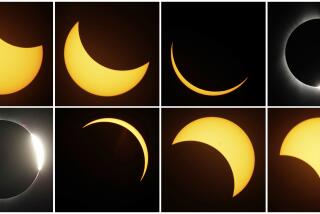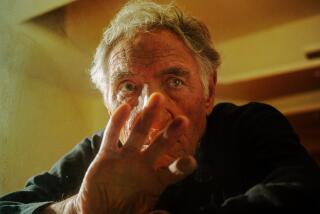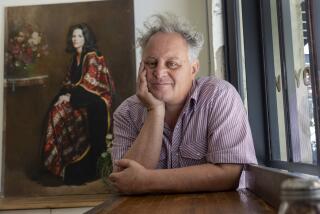Astronomical sleuth reveals the timing of the iconic 1945 ‘Kiss’
It’s an iconic image: A sailor kisses a nurse in Times Square after hearing the news that World War II was officially over — just after 7 p.m. on August 14, 1945.
Or maybe not.
Some skeptics are now challenging that widely accepted story. In their version of events, the famous kiss captured by Life magazine photographer Alfred Eisenstaedt may have occurred more than an hour before the official announcement that the war had ended.
And they’ve got science on their side.
“I’m not the expert on who the sailor is, or who is the nurse, but from the sunlight and the shadows I can say with certainty that the picture was taken at 5:51 PM,” said Don Olson, a professor of physics and astronomy at Texas State University in San Marcos and ringleader of the group.
Olson calls himself a celestial sleuth, and he has a history of using astronomy to ground famous works of art in time and place.He was able to pin down the exact month, day, hour and minute of two of Ansel Adams’ Yosemite photographs by analyzing the angles of various shadows in the pictures as well as the tilt of the moon, among seven other lines of evidence.
He has determined exactly when and where Vincent Van Gogh made his 1889 painting “Moonrise,” as well as the precise time and place where Claude Monet painted his first impressionist work — “Impression, Soleil Levant” — in 1872.
Olson has also used his unique skills to solve military puzzles. For example, he concluded that the USS Indianapolis may have been especially vulnerable to a Japanese submarine in July of 1945 because it was back-lit by a bright moon that was three quarters full.
But the Kiss mystery was a particularly hard one to solve, he said.
Olson launched on the project in 2010, after his friend and fellow astronomer Steven Kawaler became embroiled in an online debate over what time the picture was taken.
The first clue that the photo was taken before the official VJ-Day announcement came in a New York Times article about a woman named Gloria Bullard. She was a 19-year-old nursing student in 1945, and she was caught grinning at the kissing couple in a similar picture taken by Victor Jorgensen at the same time Eisenstaedt snapped his classic shot.
Bullard remembered seeing the kiss as she walked through Times Square on her way home to New Canaan, Conn. (She was the recipient of many similar kisses herself). She also recalled that it took more than two hours by bus and train to get home that night. When she arrived, dusk was starting to settle, and the streetlights were just turning on.
If Bullard’s story is true, the famous kiss must have taken place “several hours” before the war was officially declared over, at 7 PM local time.
After studying the picture, Kawaler noticed that Eisnestadt’s photo included a picture of a clock, tucked into the “O” of the sign for Bond’s Clothing Store.
“To me, it looks like about 6:50PM, but at this strange angle it could even be 5:50PM,” he wrote in the online comments section of the story. “Certainly not after 7:03.”
“If that clock was correct, it would prove that Life took some liberties (though not at the level of the sailor at the center of the image),” he added.
Discussion continued, and soon Kawaler asked his friend Olson to investigate.
Olson was intrigued.
He quickly determined that the clock could not answer the question. The minute hand was clearly pointing to the “10,” but the hour hand was unusually short, making it difficult to read with certainty from the oblique angle in the photograph.
But the picture did contain another clue — a distinctive shadow on the Loew’s building, just behind the Bond building.
He determined that the top of the shadow was about 16 feet across because it covered a little bit more than two windows before tapering off. But where was it coming from?
For years, Olson puzzled over what had cast this shadow. He studied hundreds of photos of Times Squares from the 1930s and ‘40s. He consulted vintage maps of Manhattan as well as blueprints of the buildings that were there at the time.
His first guess was that the shadow was cast by a water tower on the top of the Hotel Astor, which was just west of the Loew’s building. A water tower was about the right size to cast the shadow, and the Hotel Astor was in the right place. But it turned out the hotel had no water tower on its roof — there was an elegant garden there instead.
Olson next wondered if the Paramount building might be responsible for the shadow, but he couldn’t make it line up right. He tried the Hotel Lincoln and The Times building itself, but nothing worked out mathematically.
His “ah ha!” moment occurred four years into the project, when he came across a vintage photo of the Hotel Astor that included an L-shaped sign advertising its rooftop garden.
Blueprints from Columbia University revealed that the top of the sign was 18-feet wide — just the right size to cast a 16-foot shadow on a building more than 100 feet away.
With that clue in hand, he was able to use spherical trigonometry and projective geometry to calculate where in the sky the sun had to be for the sign to cast the exact shadow depicted in the photograph.
The math said the time of the photograph had to be 5:51 p.m. To make sure that was right, he asked his friend and frequent collaborator Russell Doescher to build a cardboard scale model of Times Square in the 1940s.
Using a mirror on a sunny day, the two astronomers were able to throw the sun’s rays from any direction they wanted. And sure enough, when they arranged it so that the mirror mimicked the angle of the sun at 5:51 p.m. on August 14,1945, they were able to replicate the exact size, shape and position of the shadow in the photograph.
“I said, ‘Russell, I can sleep better at night now,’“ Olson said.
Olson, Doescher and Kawaler laid out other lines of evidence that support these astronomical-based conclusions in an article in the August 2015 issue of Sky and Telescope. A good deal of the work involved spending time on EBay acquiring vintage photographs of Times Square buildings, old newspapers to learn exactly when the sun set that day, and a 1945 time table that identified the train Bullard took home that night.
“There were only a few trains on the branch line up to New Canaan, and the one she likely took would have arrived there shortly after 8 p.m.” Olson said. “If her story is accurate, it is evidence that our astronomical calculations are consistent with her story.”
Although this mystery may be solved, his sleuthing continues. Olson is already at work using an analysis of sunlight and the length and direction of shadows to date one of Ansel Adams’ signature images. (He won’t say which one.)
He’s also trying to uncover how celestial conditions helped a German submarine sink a British battleship near the beginning of World War II.
“Studying projects like this makes our lives richer,” he said.
Love science? Me too! Follow me on Twitter @DeborahNetburn and “like” Los Angeles Times Science & Health on Facebook.







